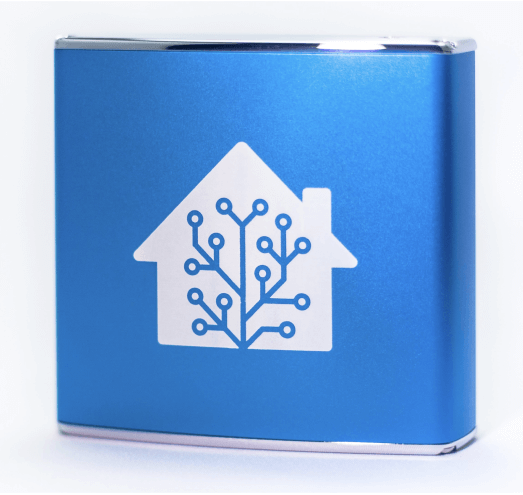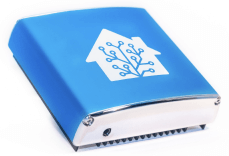Home Assistant Blue
After the Home Assistant conference on the 13 dec. 2020, where the Home Assistant blue was announced, I think it is time to make a post about how I run Home Assistant, because I have been using the Odroid N2 for a longer time, and is very pleased about it.



What is the “Home Assistant blue” ?
The Home Assistant blue is the odroid N2+ in a bundle with a 128GB eMMC, the Home Assistant aluminium case, and Home Assistant preinstalled:
The oficial Home Assistant Blue page
Odroid N2+ from the manufacture: Hardkernel
I think the new aluminium case looks fantastic, and if I did’nt already have an odroid n2, I would buy this one. (it is also already out of stock) To explain why this would be my number one recommendation right now for Home Assistant, I will list my Home Assistant history
History
I started playing with Home Assistant in 2016 (The IHC integration was “release” to public in 2017). I had been looking at it before, but prior to this I had too many problems with Home Assistant. Here is listed in cronological order the main devices I have been using for running Home Assistant.
Raspberry Pi 2 was the first device I used for running Home Assistant. It was not running very well, and at some point the SD card died. I was not running the hassio (Now Home Assistant OS), because I wanted to do other things too on the device. I think the current Home Assistant OS is better, but have not really used it.
Raspberry Pi 3 When I had to do a new installed I upgraded to raspberry 3, it was running a little better, but I was not happy about running from an SD card, or the performance. I did experiments with an external usb hard drive, but the Pi 3 did only have USB 2.0
Odroid xu4 To get better performance, USB 3.0, and the eMMC disk, I bourght the Odroid xu4. I also had an external USB 3.0 ssd disk attached. This was a big step forward from the raspberry pi’s. This the first time where I was really happy about the Home Assistant performance and stability.
Odroid N2 I switched to Odroid N2, because I got it as a gift. This is a running little better than the xu4, and has a better cooling. I would say that both odroid are running very good. This is what I am currently using in my house. I have it setup with docker and Home Assistant running in a docker container. I run several other things on this device, and it also servers as my storage/nas server with a big 8T USB 3.0 disk attached. I am currently running about 10 containers with different stuff without any problems.
Odroid H2+ I have also resently bourght the odroid H2+ and maybe I will move Home Assistant to this device. There are several reasons why I wanted to try the Odroid H2+. It is x86 based, and x86 is still better supported regarding drivers, docker images e.t.c. I think I have used too much time trying to get stuff working on arm linux that will run out of the box on x86. The second reason is the ram – you add your own rams to Odroid H2+(so it is probably not concidered is single board computer), and I have add 32 GB ram. That may be a little overkill, but that is the max ram you can add so why settle for less! The Odroid H2+ has an M.2 interface for a SSD harddisk, som yet another big step up from the eMMC. Finally the H2+ has 2×2.5GB ethernet ports, making it even better as a nas server. Docker is also nice when you want to try something and don’t want to mess up your regular linux install, and it is much faster to start a new container than starting a virtual linux machine.
Developing for HA When developing something for HA I use my regular PC with Visual Studio Code running HA in a docker container. I started out using Visual studio and HA directly in a python on the computer, but the combination of Visual studio code and a docker container is mush better.
Why not Raspberry Pi 4?
All the raspberry PI’s are fine Single board computers, and I use them alot. I just don’t think they are perfect for Home Assistant because of the limited IO. Running from an SD card is not something I like to do with Home Assistant. I have not jet tried the Raspberry PI 4, because I am very pleaced with all the Odroid models. Each one do have some pro/con. The Raspberry PI’s do have better community support, but the Odroid are completely opensource. Raspberry Pi 4 also did have some initial issues with heating e.t.c. (This may have been an initial issue – I have not been checking up on that). Overall the performance of the Odroids are better than the Raspberry pi.
Why so exited about the Home Assistant Blue?
I have several times been asked about how I run Home Assistant and what I would recommend. If you are not so technical and don’t want to control you own linux, you should defently go with the Home Assistant OS, and until now the best option was a Raspberry PI. And since my experince with Odroids was way better than Raspberry PI, I have been hesitant about writing anything about it. So I thing it is great that the Odroid N2 is now an official supported Home Assistant device running the Home Assistant OS, making it easy for everyone. And Additionally the blue aluminium case looks fantastic.
I must add that I have not tried the Home Assistant OS on the Odroid N2, because I want to be in control and run other things too, but I assume it is working fine because it is now official supported. Runing it in docker on Odroid N2 is a pleasure (but that is only for the real nerds who want to be in controll, and do other things too on the device)
If you have good/bad experince running Home Assistant on other devices do tell in the comments below.
P.S. the Odroid N2+ is an opgraded version of the Odroid N2 – they are almost identical. The N2+ has incressed the CPU clock a bit – so it should run a bit faster.
Comments
The comments below has been imported from the old website. Currently comments are readonly, meaning you can not make new comments. You will be able to do that when it is ready. For now if you want to get in touch, you can send me an email. If you have problems with something that has a github repository, please make a github issue.